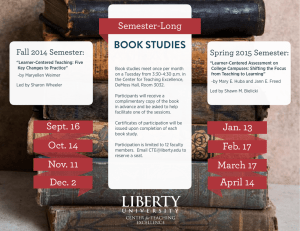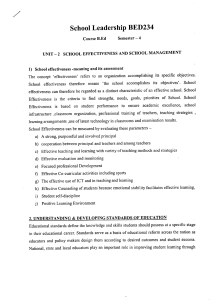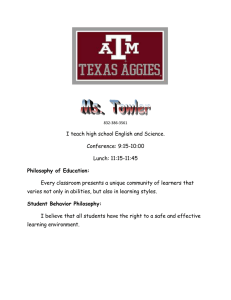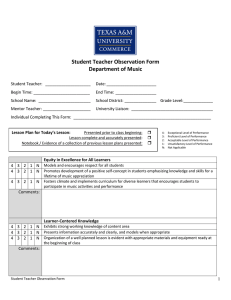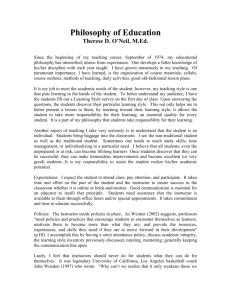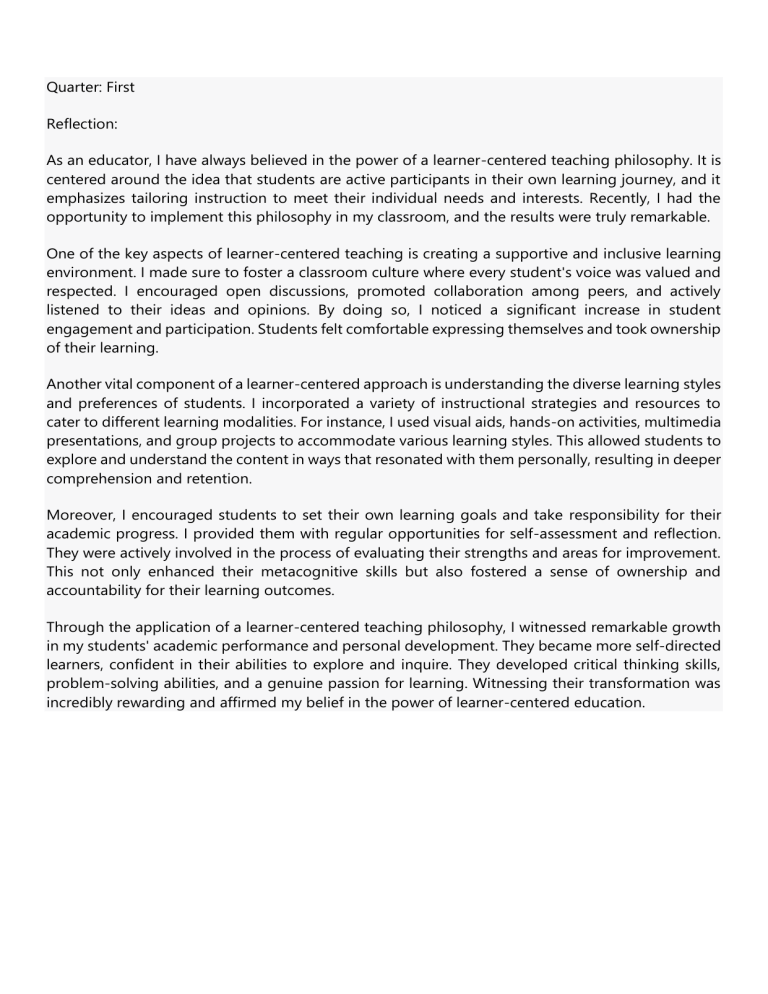
Quarter: First Reflection: As an educator, I have always believed in the power of a learner-centered teaching philosophy. It is centered around the idea that students are active participants in their own learning journey, and it emphasizes tailoring instruction to meet their individual needs and interests. Recently, I had the opportunity to implement this philosophy in my classroom, and the results were truly remarkable. One of the key aspects of learner-centered teaching is creating a supportive and inclusive learning environment. I made sure to foster a classroom culture where every student's voice was valued and respected. I encouraged open discussions, promoted collaboration among peers, and actively listened to their ideas and opinions. By doing so, I noticed a significant increase in student engagement and participation. Students felt comfortable expressing themselves and took ownership of their learning. Another vital component of a learner-centered approach is understanding the diverse learning styles and preferences of students. I incorporated a variety of instructional strategies and resources to cater to different learning modalities. For instance, I used visual aids, hands-on activities, multimedia presentations, and group projects to accommodate various learning styles. This allowed students to explore and understand the content in ways that resonated with them personally, resulting in deeper comprehension and retention. Moreover, I encouraged students to set their own learning goals and take responsibility for their academic progress. I provided them with regular opportunities for self-assessment and reflection. They were actively involved in the process of evaluating their strengths and areas for improvement. This not only enhanced their metacognitive skills but also fostered a sense of ownership and accountability for their learning outcomes. Through the application of a learner-centered teaching philosophy, I witnessed remarkable growth in my students' academic performance and personal development. They became more self-directed learners, confident in their abilities to explore and inquire. They developed critical thinking skills, problem-solving abilities, and a genuine passion for learning. Witnessing their transformation was incredibly rewarding and affirmed my belief in the power of learner-centered education. Journal Entry: Date: Today marked a significant milestone in my teaching career as I wholeheartedly embraced and applied a learner-centered teaching philosophy in my classroom. The excitement and anticipation I felt as I entered the classroom were tangible. I had spent considerable time planning and preparing for this shift, and I was eager to witness the impact it would have on my students. Creating an inclusive and supportive learning environment was my first priority. I wanted every student to feel valued and respected, to know that their voice mattered. As I facilitated class discussions, I noticed a profound change in the dynamics. Students actively engaged with one another, sharing their thoughts and challenging each other's ideas in a constructive manner. The level of enthusiasm and energy in the room was palpable, and it was clear that they felt safe to express themselves. Throughout the day, I incorporated various instructional strategies to cater to the diverse learning styles and preferences of my students. From visual aids to hands-on activities, each lesson was carefully designed to provide multiple entry points for understanding. I observed how students eagerly explored the content using their preferred learning modalities. It was incredibly gratifying to see their faces light up as they made connections and achieved those "aha" moments. An essential aspect of a learner-centered approach is empowering students to set their own learning goals. I introduced the concept of self-assessment and reflection, allowing them to evaluate their progress independently. It was inspiring to witness their growth mindset in action as they identified areas for improvement and strategized ways to overcome challenges. They were taking ownership of their learning journey, and it was beautiful to behold. As the day drew to a close, I couldn't help but reflect on the incredible transformations I witnessed. My students had become active participants in their own education, fueled by curiosity and a genuine passion for learning. They were developing not only academically but also as individuals with critical thinking skills, empathy, and a growth mindset. Today reinforced my belief in the power of a learner-centered teaching philosophy. By shifting the focus from teacher-led instruction to student-centered exploration, I witnessed the true potential of education. It is a journey of self-discovery and empowerment, where students develop the skills and mindset to thrive in an ever-changing world. I am grateful for the opportunity to be a facilitator of this transformative process and look forward to continuing on this learner-centered path with my students. Quarter: Second A learner-centered philosophy is an educational approach that places the learner at the center of the learning process. It recognizes that each individual has unique needs, interests, and abilities, and aims to create an environment that supports and nurtures their growth and development. Here are a few reflections on the learner-centered philosophy: 1. Individualized Learning: Learner-centered philosophy emphasizes the importance of tailoring instruction to the needs of each student. It recognizes that learners come from diverse backgrounds and have different learning styles and paces. By accommodating individual needs, such as through personalized learning plans or flexible pathways, learners can engage more deeply with the material and achieve better outcomes. 2. Active Engagement: Learner-centered philosophy encourages active engagement and participation from the learners. It promotes interactive and collaborative learning activities, where students take ownership of their learning and become actively involved in the learning process. This approach fosters critical thinking, problem-solving skills, and a deeper understanding of the subject matter. 3. Focus on Lifelong Learning: Learner-centered philosophy aims to cultivate a love for learning and the development of lifelong learning skills. It goes beyond the acquisition of content knowledge and focuses on fostering curiosity, creativity, and a growth mindset. Learners are encouraged to explore their interests, ask questions, and pursue independent inquiry, which prepares them for continuous learning beyond formal education. 4. Teacher as Facilitator: In a learner-centered approach, the role of the teacher shifts from being a sole authority figure to that of a facilitator and guide. Teachers create a supportive and inclusive learning environment, where they provide guidance, feedback, and resources to help learners achieve their goals. They adapt instructional strategies to meet the diverse needs of students and foster a collaborative relationship with learners. 5. Assessment for Learning: Learner-centered philosophy emphasizes the use of varied and authentic assessments that focus on the learner's progress and growth rather than just final outcomes. Assessments are used to provide feedback, identify areas of improvement, and guide further learning. This approach promotes a more holistic understanding of a student's abilities and helps them develop metacognitive skills. 6. Empowerment and Autonomy: Learner-centered philosophy seeks to empower learners and promote their autonomy. It recognizes that learners have unique interests, strengths, and aspirations, and values their input and choices in the learning process. By giving learners agency, they become active participants in their education, developing self-confidence, motivation, and a sense of ownership over their learning journey. 7. Overall, a learner-centered philosophy acknowledges that education is not a one-size-fits-all approach. It recognizes the individuality and potential of each learner and seeks to create an environment that fosters their growth, curiosity, and love for learning. By shifting the focus from teaching to learning, this philosophy aims to create meaningful and transformative educational experiences. Quarter: Third Today marked an important milestone in my teaching journey as I fully embraced and implemented the learner-centered teaching philosophy in my classroom. The learner-centered approach has always resonated with me, but I had previously struggled with fully integrating it into my teaching practice. However, after attending workshops and conducting thorough research, I was determined to make a positive change in my students' learning experiences. I started the day by setting clear goals for my class session and identifying the key learning outcomes I wanted my students to achieve. However, instead of dictating these goals to my students, I presented them as questions to promote curiosity and engagement. I wanted to spark their interest and encourage them to take ownership of their learning. During the class, I actively fostered a collaborative learning environment by encouraging open discussions and student participation. I divided the students into small groups and assigned them different tasks related to the day's topic. This allowed them to work together, exchange ideas, and learn from one another's perspectives. It was heartening to witness the enthusiasm and energy that filled the classroom as students eagerly shared their insights and supported each other's learning. To further promote learner autonomy, I incorporated various hands-on activities and real-life examples into the lesson. I aimed to make the content relatable and applicable to their lives, enabling them to connect theory with practice. I also introduced technology tools and resources that allowed students to explore topics at their own pace and tailor their learning experience to their individual needs and interests. Throughout the session, I regularly assessed my students' understanding and progress. Instead of relying solely on traditional exams, I incorporated formative assessments such as class discussions, quizzes, and reflective journals. These assessments helped me gauge their understanding and provided valuable feedback for both the students and myself. I emphasized the importance of reflection and metacognition, encouraging students to evaluate their own learning processes, strengths, and areas for improvement. As the session drew to a close, I devoted time to reflection and feedback. I asked my students to share their thoughts on the learner-centered approach and their experiences during the class. Their responses were overwhelmingly positive. Many expressed how they appreciated the opportunity to actively engage in their learning, collaborate with their peers, and apply their knowledge in practical ways. It was evident that they felt empowered and valued as active participants in the learning process. Looking back on this experience, I feel a deep sense of fulfillment and motivation. The learnercentered teaching philosophy has had a profound impact on both my students and myself. Witnessing their growth, enthusiasm, and the joy of learning has solidified my belief in the power of this approach. I am committed to continually refining my practice, exploring new strategies, and seeking innovative ways to further enhance the learner-centered environment in my classroom. Overall, today's application of the learner-centered teaching philosophy has been a resounding success. It has reinforced my belief that when students are at the center of their learning, their motivation and engagement soar, leading to deeper understanding and meaningful knowledge construction. I am excited to continue this journey, as I am confident that by prioritizing the needs, interests, and abilities of my students, I can truly make a lasting impact on their educational experiences. Quarter: Fourth A reflection on Learner centered teaching philosophy in my teaching career Throughout my teaching career, I have embraced and implemented a learner-centered teaching philosophy, which has significantly impacted both my students and myself as an educator. This pedagogical approach places the learner at the center of the teaching and learning process, recognizing their unique needs, abilities, and interests. Looking back, I can reflect on several key aspects and benefits of learner-centered teaching that have shaped my professional journey. First and foremost, learner-centered teaching acknowledges the diverse backgrounds and learning styles of students. It encourages me to create a supportive and inclusive classroom environment where all students feel valued and respected. By recognizing and respecting their individuality, I can better cater to their specific needs and interests, fostering a positive and engaging learning experience. One of the fundamental principles of learner-centered teaching is promoting active learning. Instead of solely relying on lectures and rote memorization, I strive to design interactive activities, discussions, and group projects that encourage students to actively participate in their learning. This approach not only enhances their understanding and retention of the material but also develops crucial skills such as critical thinking, problem-solving, and collaboration. Moreover, learner-centered teaching places a strong emphasis on student autonomy and empowerment. I aim to create opportunities for students to take ownership of their learning, enabling them to set goals, make decisions, and reflect on their progress. By giving them a sense of agency, I have witnessed increased motivation and engagement among my students. They become more invested in their education and develop a deeper understanding of the subject matter. Another significant aspect of learner-centered teaching is the focus on real-world application. I constantly strive to connect the content I teach to practical and meaningful contexts, helping students understand how the knowledge and skills they acquire can be applied beyond the classroom. By relating the material to their personal experiences or future aspirations, I can foster a deeper level of comprehension and make learning more relevant and impactful. Implementing a learner-centered teaching philosophy has not only benefitted my students but has also had a profound impact on my professional growth. It has challenged me to continually reflect on my teaching methods, seek feedback from my students, and adapt my approach based on their needs. This iterative process has allowed me to refine my instructional strategies and become a more effective educator. Moreover, learner-centered teaching has reminded me of the importance of being flexible and open-minded. Each student brings their unique strengths, weaknesses, and interests to the classroom. By embracing this diversity and tailoring my teaching accordingly, I have been able to create a supportive and inclusive learning environment that celebrates individual differences and encourages growth. In conclusion, embracing a learner-centered teaching philosophy has been a transformative experience in my teaching career. It has enabled me to create an inclusive and engaging classroom environment, foster active learning, promote student autonomy, and connect learning to real-world contexts. The impact on my students' growth, motivation, and enthusiasm for learning has been evident, and it has also pushed me to continually reflect, adapt, and improve as an educator. Overall, learner-centered teaching has been a cornerstone of my pedagogical approach and will continue to guide my practice in the future
